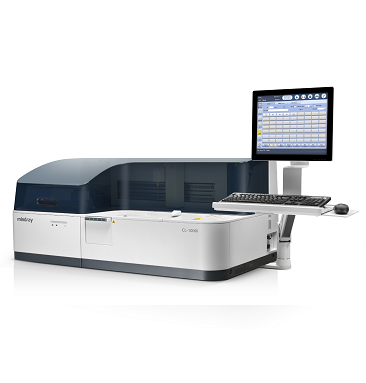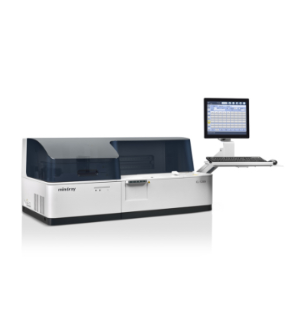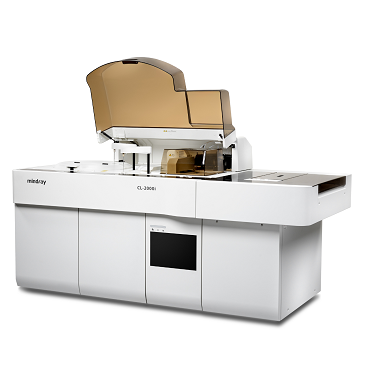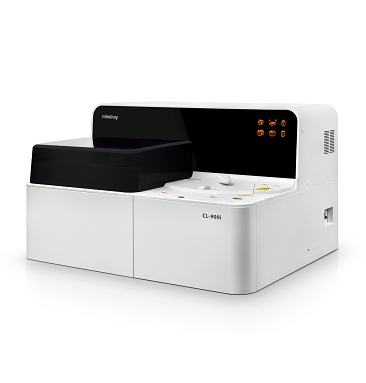Heart Capturer:
A Chase Targeting the Microworld




"Truth Capturer" — Antigen-Antibody Detection Model Sculpture
This sculpture is now standing in the IVD exhibition hall at Mindray's headquarters. When you look at the sculpture closely, you can see that its central part is like an irregular "paper cluster" formed by interlaced three-color wooden pieces. It is held firmly by the Y-shaped "tentacles" at the upper and lower ends.
"Truth Capturer" — Antigen-Antibody Detection Model Sculpture
This structure is inspired by the detection model of the cardiac marker — troponin, where the detection and capture antibodies work together to capture antigen complexes. The combination of the beveled, flipped wooden pieces reproduces the dynamic, folded structure of the proteins.
In immunoassay, the "chase" between antigens and antibodies is a key part of the effort to ensure prompt detection from patient samples. For decades, scientists have kept exploring troponins in a bid to maximize the chance of survival from heart attacks. Earlier and more accurate testing means more effective treatment.
Undoubtedly, bringing biomarkers from scientific research to clinical application requires interdisciplinary collaboration.
Fred S Apple, PhD
Chair, IFCC Committee on Clinical Application of Cardiac Biomarkers (C-CB)
Member,
AACC Academy Laboratory Medicine Practice Guidelines on Cardiac Markers
Chief
Scientific Advisor, HyTest

We've been trying to do educational products since the last several years. It's a combination of industry, academic, and hospital-based people. It really works when you put industry together. And one of our focuses is to understand what's going on with troponin, especially high-sensitivity troponin.


Dr. Jianwen He
Chief Scientific Officer, Mindray IVD

IVD is a bridge that leads science to clinical practice, that is, the clinical application of experimental science is a 'view from this bridge'. The immunoassay technology is the most brilliant innovation sparked by the convergence of biology and engineering. The value-adding innovation achieved by mastering core raw materials and applying them in clinical settings is the best view we can enjoy from this IVD bridge.
Before getting into the cross-disciplinary interactions and convergence, let's look at a "chase" targeting the microworld and learn the story of the "Heart Capturer".
From CK to cTnI
"Old Capturer" Versus "New
Challenger"
The innovation of biomarkers is a major challenge for immunoassay. The antibody's ability to accurately "capture" the marker antigen determines whether prompt detection is possible from patient samples. Thirty years ago, CK and its isoenzyme CK-MB played the role of "golden capturer" in the diagnosis of myocardial infarction.

False positive results of CK-MB obtained from an
experiment in the 1980s.
The hear-shaped stripe was a creative representation derived from the scientists' special
treatment to the gel.
IFCC's Working Group on Biochemistry held a research conference in Germany (first, second, and fourth on the left: Fred Apple, Maria Severina, and Alex Katrukha)

This old capturer from skeletal muscle was prone to causing false positive results due to its low specificity, which often interfered with diagnosis. In the 1990s, cardiac troponin I (cTnI) started to draw attention for its excellent performance in diagnosis. It was then that HyTest became an early pioneer in cTnI research.
During a research meeting of the International Federation of Clinical Chemistry and Laboratory Medicine (IFCC), HyTest scientists and several IFCC members took a boat ride to a foothill in southern Germany, drinking beer and talking about the future of troponin. During this period, the development and application of cTnI products had been accelerated by the communication and cooperation between academic, industrial, and medical professionals.

In 2004, HyTest's cTnI complex material was chosen by AACC as a raw material for the international troponin standard. HyTest's unceasing research progress is accompanied by the industry's increasing understanding of troponins. With its superior sensitivity and specificity, this "new challenger" is gradually replacing CK and CK-MB as the gold standard for myocardial detection.
Since the 1990s, HyTest has developed a series of high-quality products for use in the forecast and diagnosis of myocardial infarction and the heart failure area, providing more valuable evidence for the companion diagnostics of cardiac diseases.
Chasing the ever-changing antigen from the heart to the
periphery
Capturing the enemy
In battlefield, combating the enemy always requires changes in tactics. In employing myocardial markers as the weapons in this combat, HyTest has been constantly tracing the dynamic changes of troponin on the micro scale after the onset of the disease.
Scientists observed that after the onset of myocardial infarction, troponin is released from the heart into the peripheral circulation, and its complexes would appear in different forms over time. For over two decades, HyTest's moving increasingly close to the truth has pushed it into rethinking how to identify highly specific antibodies that can adapt to changes and deliver accurate test results.


Change of cTn forms in blood of patients with MI over time
With a keen focus on basic research, HyTest works consistently to drive standardized and scientized clinical testing. HyTest won the NACB Distinguished Abstracts Award for its AACC posters in 2008, 2011, and 2016, and has published more than 50 papers in peer-reviewed international journals, making significant contributions to the research on markers.

HyTest's talent base
more than 0
of R&D personnel have a
doctor's degree

SCI papers
0

Citations
0
Hundreds of experiments
yield the optimal tactic
Since troponin exists in a variety of forms, it is necessary to build a combat system to recognize complexes.
Based on the research on complexes, the scientists started to experiment on the recognition sites to identify the optimal capture/detection antibody pair. They intended to come up with a "proactive and adaptable" tactic to eliminate interferences and precisely capture targets in the molecular stabilization region.

Schematic illustration of cTnI testing system

After performing hundreds of screening experiments, HyTest finally obtained a brand-new pairing model, which marks a new height in sensitivity. Improved sensitivity will expand the field of vision to help detect earlier changes, meaning the possibility of discovering even more clinical applications.

The exploration is still
underway
Tip of the iceberg
With the ongoing advances in troponin research, scientists have found that the diagnosis of myocardial infarction is only the tip of the iceberg in terms of the application of troponin. There is still much to explore: diagnosis of myocardial injury, mechanism of troponin release, and relationship between troponin composition and disease, and many more.
As the exploration is still underway, the view under the iceberg will provide immunoassay professionals with the motivation to forge ahead and innovate better reagents.

Besides myocardial detection, the exploration in the chemiluminescence world is also like an iceberg adventure, with greater possibilities to unlock on a deeper and broader level. Through over two decades of research, HyTest has overcome challenges in tumor, infectious diseases, inflammation, among others, and mastered the core raw materials.
The design of antigens and antibodies is the most critical step in determining the quality of reagents. Reagents based on these high-quality raw materials will be the best capturer to help physicians diagnose diseases.

Learn more
From "numbers" to "value" From science to
clinical practice
View from the bridge
IVD is a bridge that leads science to clinical practice, that is, the clinical application of experimental science is a "view from this bridge".


HyTest R&D and Mindray Reagent R&D
The core raw materials of made-in-China IVD reagents had long been monopolized by international companies, creating a major barrier to independent research by Chinese enterprises.
In order to innovate on reagents from the source and deliver quality reagents that give accurate test results, Mindray has acquired HyTest to bring together a wider group of scientists to unlock more possibilities with immunodiagnostics.

By building a closed-loop system that encompasses everything from antigen/antibody development through to reagent design to test instrument development and manufacturing, Mindray will orient its entire R&D path toward clinical needs, building a bridge from science to clinical practice.
In delving deep into the microworld to study life sciences, Mindray has been dedicated to innovating technologies and methods to design testing principles, to obtain numbers from testing systems, and to create value from clinical application. The shift from "numbers" to "value" is where the real value of IVD lies and what to view from Mindray's IVD bridge.

References:
1. Katrukha IA, Katrukha AG. Myocardial Injury and the Release of Troponins I and T in the Blood of Patients. Clin Chem. 2021 Jan 8;67(1):124-130.
2. Technical Report: A New Generation of Cardiac Troponin I Testing System Based on Troponin Complex, HyTest.




